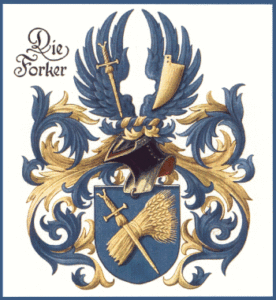– earliest Forker deposits in Germany (Saxony) –
To explain, first a map section: “Saxony – Dresden”.
The area east of Dresden to Neustadt in Saxony. After about two-thirds of the way, the castle town of Stolpen (known for the mistress of Augustus the Strong who was imprisoned here). In the street village of Langenwolmsdorf and around it (Stolpen, Lauterbach, Polenz) the earliest entries of the name Forker can be found in the church books.
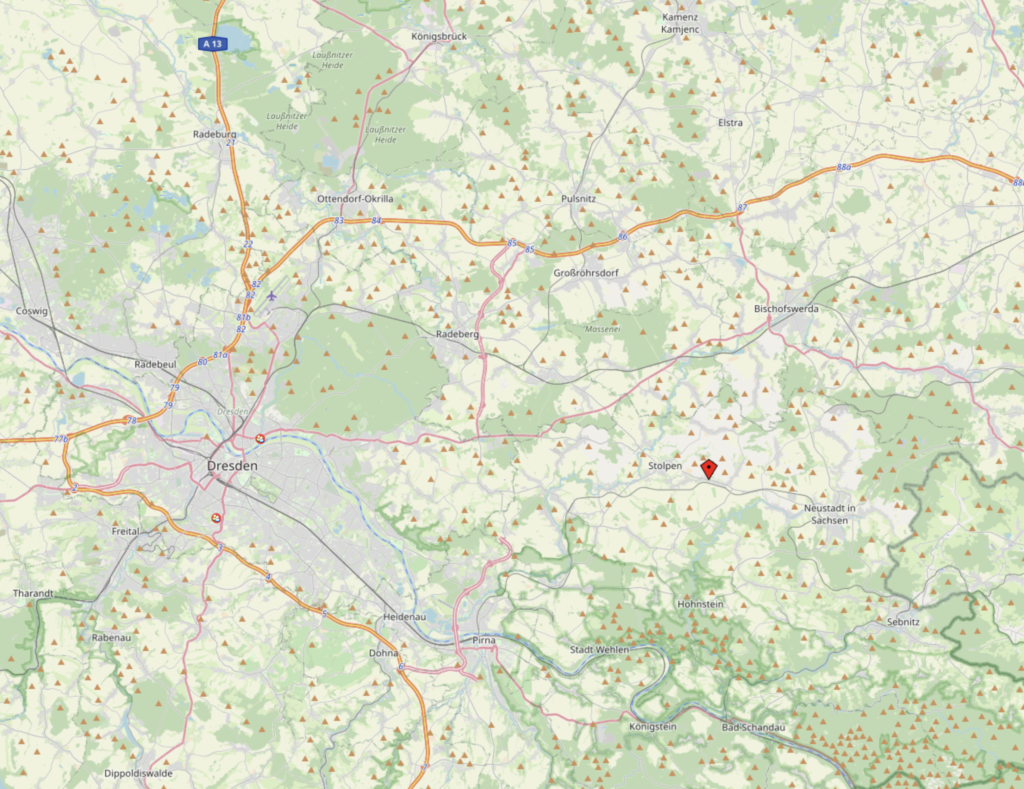
Figure 1: Map section from OpenStreetMap
If you ask yourself about the origin of his “Forker ancestors“, you will quickly find out that the grandparents mostly came from Protestant Saxony, but their other ancestors came from the area around 01833 Stolpen and ultimately only from Langenwolmsdorf or from the neighboring town to the north Lauterbach or Polenz in the direction of Neustadt.
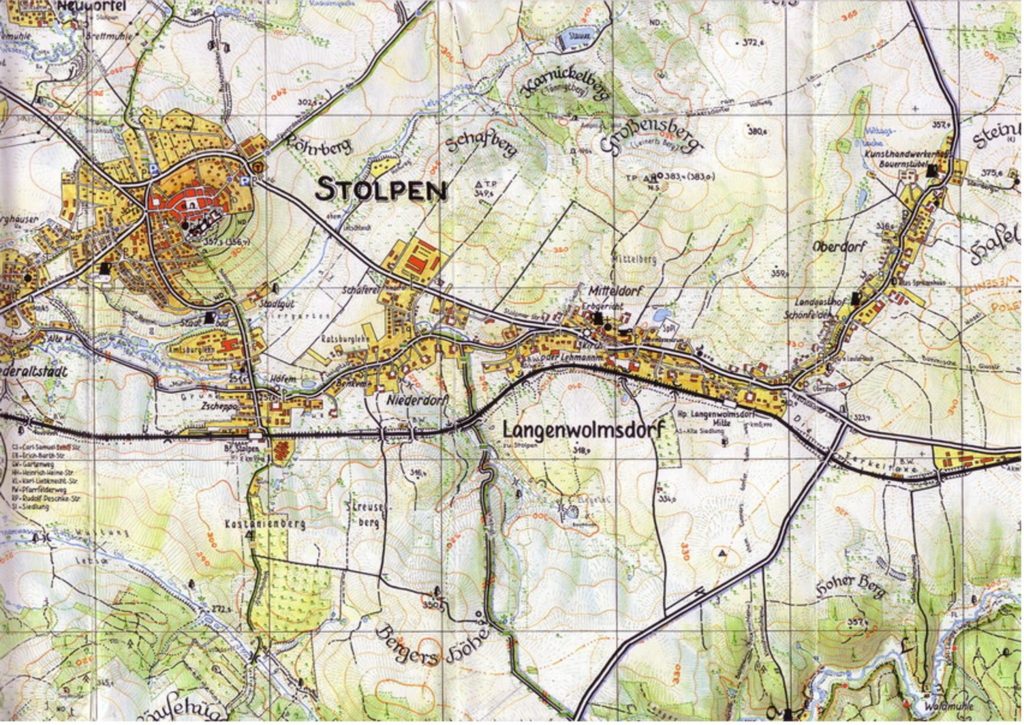
The top ancestors of the three main tribes actually come from Langenwolmsdorf.
Matthes Forker (line # 5412) the upper Müller died on December 4th, 1634, aged 80, would therefore have been born in 1554 and thus the first top ancestor, so far 274 descendants from him in 14 generations have been determined.
The linen weaver Urban Forker (stem # 1707) as the progenitor of the main line should be mentioned as the second top ancestor. So far, 17 generations with about 485 male descendants have been collected from him, who live scattered all over Germany and even as far as Australia.1
The third top ancestor is Antonius Forker senior. (Root # 3613) who must also have been born around 1559 in Langenwolmsdorf, since his son Antonius married Martha Unger in Langenwolmsdorf on November 9th, 1624. In this strain 17 generations with 171 descendants were found.1
Other Forkers mentioned earlier in Langenwolmsdorf are:
| # 7256 Nikolaus | * 1470 |
| # 7257 Blasius | * 1505 |
| # 4728 Kilian | * 1525 |
| # 7481 Caspar | * 1530 |
| # 7259 Bastian | * 1537 |
| # 4238 Nickel | * 1550 |
A filiation could not be established by any of them, since it was only mentioned in the time before the church registers.
From the Lauterbach church book we know of Mattheus Forker (tribe # 197), who could have been born there around 1562, since he died on December 8, 1633 at the age of 71, as did his wife, from the plague. To date, 1020 offspring in the 15th generation can be derived from him. Including the families living in Uruguay.2 and in Saxony.
The village chronicle of Polenz tells us about the village elder Nickel Forker (strain # 4238) * 1540 and in the church books of Neustadt there are entries about him and his children, i.e. births, marriages and deaths from 1578 – 1593. There were no other direct descendants yet assigned, although some of today’s lines have their roots in Polenz.
These are from the Ev. Church books (of the lines researched so far) show the earliest direct ancestors, from which the filiation (parents – child connection) could also be determined.
After the Reformation, at the beginning of the church book registration around 1607, there were already 9 Forker farming families in Langenwolmsdorf, who were recorded in different writings. (Forgwar, Forgkwer, Forgwer, Forckwer, Forcker, Furker). However, from 1750 only as Forker/t or rarely as Furker/t were registered.
But already in the official inheritance book3 from Stolpen with about 50 surrounding places, which has been preserved from 1559, there are only 11 and 7 Forker farming families in Langenwolmsdorf and Lauterbach. Since these cases involve the inheritance of house and land (farm and field), the father-son relationship can only be assumed to a limited extent, since cousins can also be affected.
The Dresden genealogist Mr. Kurt Wensch (1938-2012) reported on this in 1994 after he had looked through the land tax lists for Polenz from 1543, 1547, 1552 and 1554 and found: “I found the earliest evidence in 1601 when Hans Forker bought his estate sold the son. Unfortunately, there is no previous purchase book that would probably have given an indication of origin. The Forkers obviously do not belong to the indigenous people, because the review of the land tax lists did not reveal any occurrence of names”.
This means that the earliest Saxon documentary sources (church books and registers in the main state archive in Dresden) have been made accessible and further research into earlier ancestors can only lead to the origin of the name Forker (especially its early spelling).
Should Forker really be the professional title of people involved in the manufacture or sale of hay or manure forks4, then in my opinion the name should have spread earlier in large parts of Germany, such as blacksmith, shoemaker, miller, Meier and other professional names.
If we look up our names in name and onomastic books or name dictionaries, we will hardly find any explanations there. Because obviously everyone agrees that the name is not one of the names that emerged early in Germany.
So let yourself be guided further and follow the path documented in England and America, where Scottish Farquhar immigrants became Forker Farmers5, as probably also in Langenwolmsdorf. If we look at the first written fixations of our name, which were only passed on orally up to about 1530 and only from this point in time, then the suspicion arises that it is originally the Scottish name Farquhar. According to the motto: “written as heard”.
Farquhar (Scottish), from the Gaelic proper name Fearchar, derived from ancient Celtic elements meaning dear, beloved man. Of clan or separate, the Farquahrs are descendants of Farquhar Macintosh, a grandson of the Macintosh squire, who came from Braemar in Scotland before 1382.6, 7, 8
Lt. one page on the Internet: Hall of Names (Swyrich Corporation, www.Swyrich.com) Trade in genealogy (origin of names, coat of arms, clothing, etc.) Headquarters in Canada.
According to this, people from the ancient tribe of the Strathclyde Britons along the English / Scottish border (roughly along the later Hadrian’s Wall or somewhat south of today’s border) are said to have been the first to use the name FORKER. He is derived from the Gaelic Mac Fhearchair, meaning son of Farquahr and Farquhar.
Regarding the early origin it says:
The FORKER name was first found in Ayrshire, a county in the south-west of the Strathclyde region of Scotland, where they were based for several generations by Kyle Stewart.
Their history is very different from that of the Farquhar(son).
Robert Farquhar, Lord of Gilmilnescroft in the Skyle Stewart region was first recorded around 1350, the first head of the family and probably a direct descendant of Ferchart, father of Fergus. One of the chiefs of the tribe.
One of the chiefs who defined the boundaries of New Battle Abbey around 1178.
Around this time, after their decline, a branch of the family began in the north of Scotland to establish the ancestral seat of the Farquhar at Caithness near Ederlarg, or later south of it, at Braemar Castle.
FORKER hail from Gilmilnescroft in Kyle Stewart, in the Stratclyde region on the South Border of Scotland.
About 44 km south of Glasgow on the west coast is Ayr in the Firth of Clyde. From there on the A70 east 12 miles to the A76 at Cumnock. Auchinleck is located 2.5 km north-west of the A76. After 3 km north towards Sorn, you will find Gilmilnescroft.
Gilmilnescroft, now a small settlement with only sparse remains of the original Farquhar/Forker ancestral home.
So if we take a closer look at the history of the Scots, we can see that trade relations via Bruges in Belgium, but also along the entire Baltic Sea coast to Brandenburg, Prussia and the Baltic States existed as early as the 13th century, as can be seen from the Hansic charter book and can be seen from the documents of the Grand Master Order. Scots were soldiers in the French Army, but also in Russian, Polish and Prussian services. They were peddlers, later traders and settlers in Poland and Silesia and as such in Posen, Lublin and Lissa, even with the name Farquhar repeatedly attested in the 17th century. They mainly went on a pilgrimage to Rome via Danzig, Breslau and Prague.
Ultimately, 35,000 Scots lived in Poland and Silesia in the 17th century.9, 10, 11, 12, 13
From the Lexicon of Saxony, from 181415, there is a further indication for our assumption about the castle town of Stolpen, which is adjacent to Langenwolmsdorf. “The most important trades are now hosiery and linen weaving. The latter made Stolpen famous, especially before the Thirty Years’ War. In 1616 the hospital church was rebuilt from scratch, the construction costs were covered by legacies from a few English merchants, to whom linen goods were sent by Stolpen”.
So the assumption is that an earlier peddler, trader, scattered soldier or pious pilgrim fell in love with a farmer’s daughter at the beginning of the 15th century in the row hoofed village of Langenwolmsdorf (1232), which had just been reclaimed for 200 years, and settled there so that he could go to the Progenitor of all German Forker, Furker, Forkert and Furkert could be, not entirely unreasonable.
While the name Forker is ranked 19495 in Germany because of its low frequency, the German traveler in Scotland encounters a high level of recognition. If you mention your name there, the locals think they are dealing with a fellow countryman.
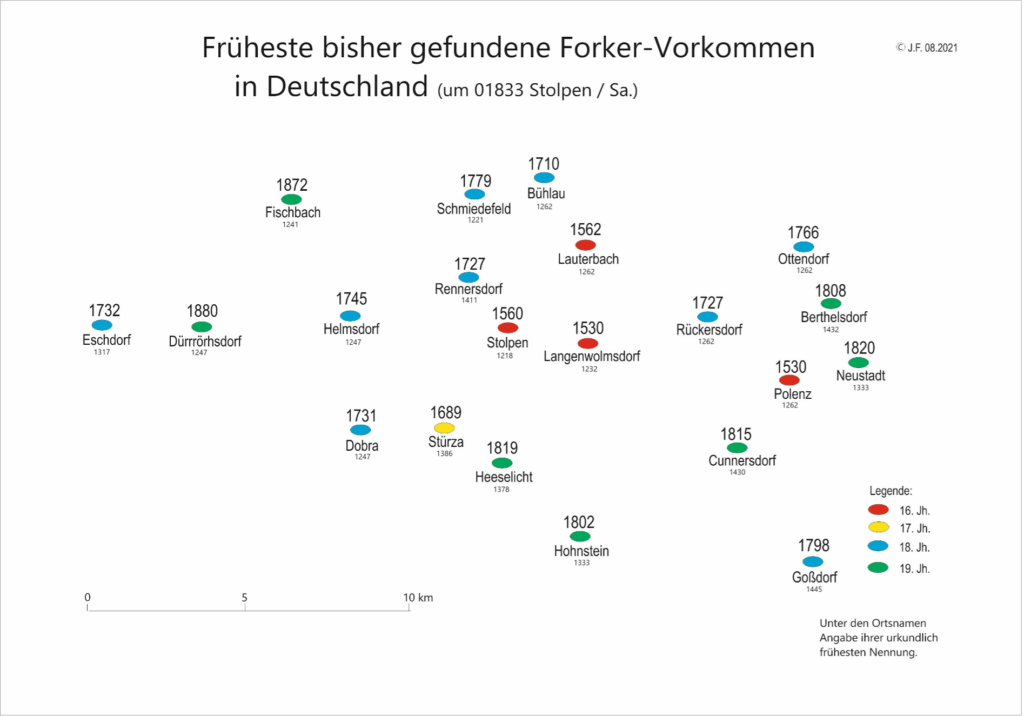
As far as we know today, there was probably another transition from Farquhar to Forkert/Furkert in Lower Silesia. Because in at least 10 villages around 20 km around Grünberg (today: Zielona Gora in Poland) there are occurrences of Forkert from 1584 whose descendants can be found all over Germany.
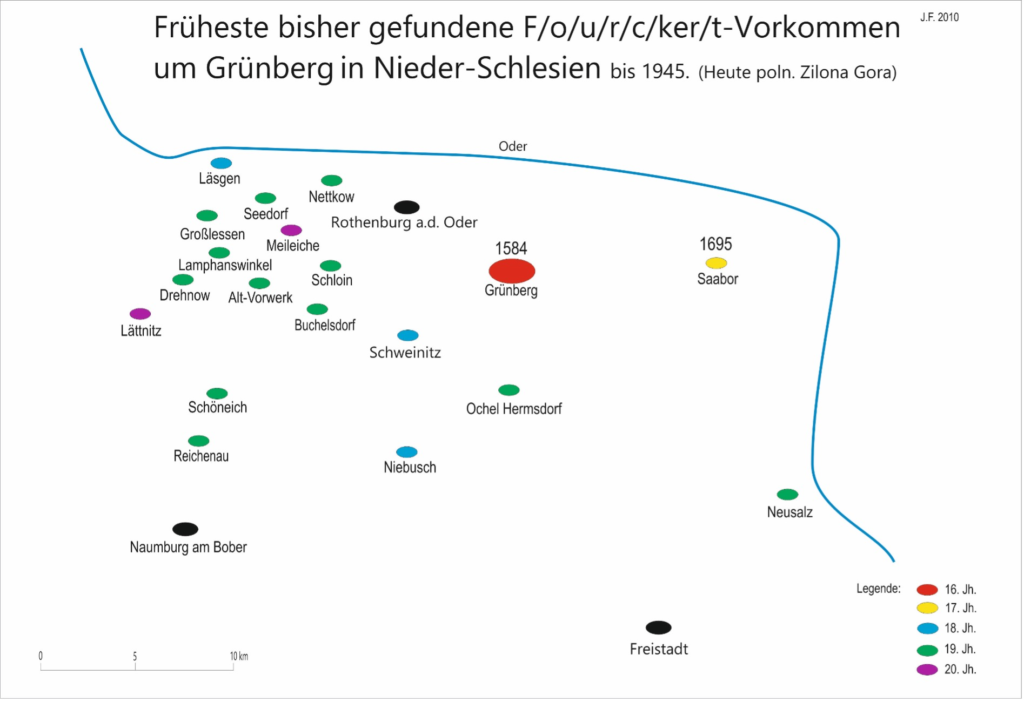
Here’s another find: About Grünberg and the Scots. 16

Reference:
1 Kirchenbücher Pfarramt Langenwolmsdorf 2 Ahnenlisten Furker: Deutsche Zentralstelle fuer Genealogie Leipzig. 3 Abschriften Hauptstaats Archiv Dresden durch Herrn Kurt Wensch. (Amtsgericht Stolpen 1791, Gerichtshandelsbuch Neustadt 1601, Amtsgericht Neustadt 1629, Landsteuerregister 1543-1554, Türckensteuerregister 1501. Steuerregister Stolpen 1566, Amtserbbuch Stolpen 1559.) 4 Im Sächsischen Hauptstaatsarchiv liegt das Landessteuerregister Nr. 292, das „Türkensteuerregister“. Das liess 1529 Herzog Georg der Bärtige für sein Land anlegen. Der Kaiser bat die Territorialherren dringend um Soldaten und Geld. Sultan Soliman II hatte in der Schlacht bei Mohacz (1526) gesiegt und belagerte Wien. Es wurden von den damaligen Verwaltungsbezirken die Ansässigen nach ihrem Besitz geschätzt. Die Steuer betrug etwa 1,1 % des angenommenen Vermögens. Diese Listen stellen für viele Orte das älteste Adressbuch dar. (Angaben von Alfred Meiche). Lt. Kurt Wensch+ :“Ist in dem von 1501 vorhandenem Türkensteuerregister, Stolpen/Langenwolmsdorf nicht enthalten“. 5 Erklärung des Namen Forker, Briefverkehr Prof. Horst Naumann, Grimma 1995 6 Kopie der Schiffspassage (Einwanderung 1746 nach Amerika) sowie Heiratsurkunde 1749, von Adam Farquhar 7 Dictionary of Surnames by Patrick Hanks and Flavia Hodge 8 The Historical Resaerch Center HESAR, S.L. 07181 Calvia (Mallorca – Baleares) 9 The Records of Jnvercauld from 1547-1828 Edited by The Rev. John Grant Michie, M.A. 10 An Historical Atlas of Scotland c. 400 – 1600 Edited by Peter McNeill and Ranald Nicholson 11 Schottisch-Europäische-Beziehungen von Thomas Smout 1986; A Note On the Scots In Poland, 1550 – 1800. 12 The Scots in Germany (Being A Contribution Towards The History Of The Scot Abroad) 13 By Th. A. Fischer Verlag Otto Schulze & Co. Edinburgh 1902. 14 Scots In Poland, Russia And The Baltic States 1550-1850 by DAVID DOBSON 15 Lexicon von Sachsen von August Schumann, Zwickau 1814, Elfter Band (Schweiz-Trebischhayn). 16 "Die letzten Deutschen".aus dem Buch von Hans-Dieter Rutsch, 2012.
